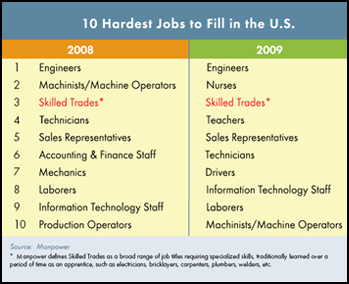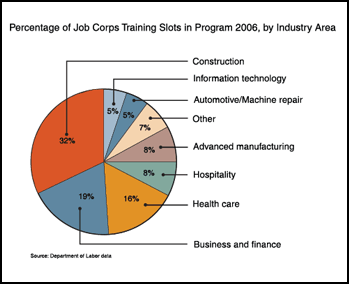| Even in this bleak economic recession, employers still scramble to find qualified workers for certain positions. |
| |
| Manpower, the international employment agency, recently released (May 2009) the findings of its fourth annual survey, The 10 Hardest Jobs to Fill. Nearly 39,000 employers in 33 countries were queried to determine the impact of talent shortages on global labor markets. In the U.S., Skilled Trades ranked third in the top ten job categories experiencing a measurable talent deficit for two consecutive years--2008 and 2009. (See chart below for the complete list.) |
| |
 |
| [Place cursor over chart to enlarge] |
| |
| Could Job Corps emerge as one solution to this recent shortage of U.S. skilled labor? |
| |
| Administered by the Department of Labor (DOL), Job Corps is the nation’s largest federally funded, residential, educational and career training program for economically disadvantaged youth ages 16-24. Many of the more than 100 technical industry occupations where Job Corps has traditionally focused its vocational training directly parallel the U.S. labor markets that now need skilled trades’ workers. |
| |
| On the surface, it seems a perfect pairing of supply and demand, but not at a perfect price. |
| |
| Since its inception in 1964, two million youths have enrolled in Job Corps. In 2007, approximately 44,000 students were enrolled at 122 Job Corps centers across the U.S. Students typically participate an average of eight months. The curriculum consists of extensive classroom instruction and vocational skills training. Students who did not graduate from high school may earn a diploma or GED. |
| |
 |
| [Place cursor over chart to enlarge] |
| |
| |
|
|
| With an annual budget of $1.5 billion, the cost to house, educate and train each Job Corps participant for the job market during program year 2007 was a staggering $34,000! Remember, that’s for a course of study that averages eight months. That would pay two years of room, board and tuition at many state universities. |
| |
| Job Corps states its typical student is an 18-year-old reading at a seventh-grade level. Seventy-five percent are high school dropouts, and more than 30% are from families on public assistance. |
| |
| From the get-go, an entering Job Corps student’s chance of success is hindered by his/her socio-economic background and low educational attainment. One might hope a young disadvantaged adult would jump at a “second chance” opportunity for free vocational training in a high-demand career providing a good income for the rest of his/her life. Apparently the value of the nation’s most expensive, taxpayer-funded, youth training program escapes an overwhelming number of its participants. |
| |
| In its June 2009 Job Corps report to Congress covering the 2007 program year, the U.S. Government Accountability Office (GAO) stated that slightly more than 50% of students left the program before completion for either violating program policies such as zero-drug tolerance, or for exceeding the number of authorized absences. Only about 36% completed program requirements and graduated as scheduled. |
| |
| It comes as no surprise that there are strong partisan viewpoints on the Job Corps. Conservatives and Republicans are calling for cutbacks; Democrats and labor leaders are staunch supporters. The GAO also reported that few evaluative studies have been conducted over the years to determine whether Job Corps is cost effective, and for the ones that have been done, the results have been inconclusive. |
| |
| However, a recent evaluation published by the American Economic Review (December 2008) assessed the impact of Job Corps on participants compared to individuals not enrolled in the program, but with demographics similar to students. For $34,000 per participant, here’s the taxpayer’s return on investment: |
| |
 |
Job Corps participants were less likely to earn a high school diploma than non-particpants (5.3% versus 7.5%). |
 |
Job Corps participants were no more likely to attend or complete college. |
 |
Four years after participating in the program, the average weekly earnings of the Job Corps group was only $22 more than the average weekly earnings of the control group, or 55 cents per hour over a 40-hour week. |
|
| |
| In addition to these less-than-impressive stats on Job Corps’ ROI, the program has drawn criticism for such internal problems as gang and drug activity; centers operating below capacity; poor recruitment efforts and retention of female students; and failure of Job Corps to detail performance outcomes in compliance with legislative reporting requirements by the DOL. |
| |
| In May 2009, President Obama announced that 121 federal programs would receive cuts, amounting to $17 billion, or only 1/2 of 1% of the $3.4 trillion budget. You guessed it: Job Corps survived. |
| |
| |
|